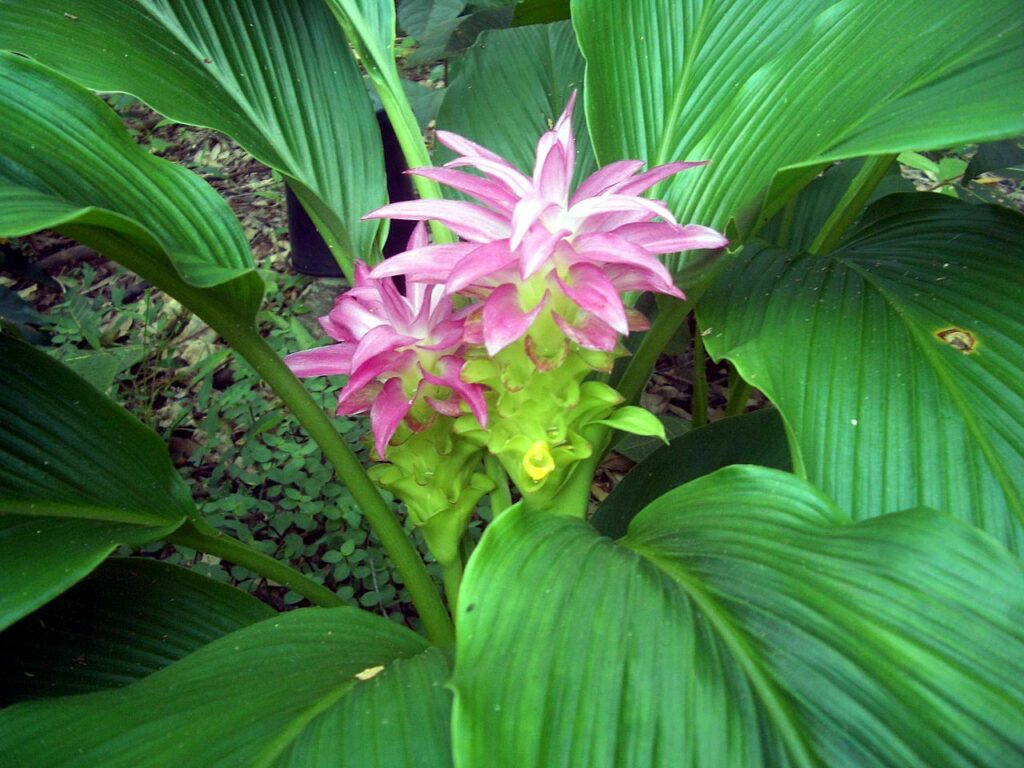
Palau
Turmeric “Telab”
Curcuma longa

General Description / Cultural Significance
About 530 miles southeast of the Philippines are the 340 islands which make up the nation of Palau. One unifying feature of Palauan culture which unites these islands is the particular association of turmeric with the birth of new life. According to Healing Waters of Omesurch by Trochol Rengulboi and Osengko Sakuma, “The most extended scent of Palau is Turmeric, Telab or Reng in Palauan. It is the most significant because when you smell it, it reminds you that a new mother has given birth and that she is ready for her baths of boiling water.” In Palau, there are very specific rituals surrounding not only the birth of a child but also the physical and emotional recovery process for the mother. Traditional Palauan doulas, called omesurches, are matched with new mothers who guide the women through a ritual healing process also called omesurch, which involves several significant aromatic plants. During omesmurch, the new mother bathes in water steeped with wax-apple (rebotel) leaves and in the morning and afternoon, mixtures of coconut oil and turmeric are applied to her skin. In the last omesmurch ritual, the omengal, the new mother sits inside a tee-pee-shaped bamboo hut where she straddles a wooden seat which allows the steam from a boiling pot of leaves and herbs underneath to scent her body. After this ceremony is completed, the omesmurch adorns the woman in a crown of flowers and a traditional skirt and covers her in a lotion of coconut oil and turmeric. Thus, in Palau, the scent of turmeric is strongly linked to motherhood, new life, and honoring the physical strength and recovery necessary after childbirth.
Turmeric also plays an important role in the cultural view of family trees and relationships between kin and villages in Palau. Turmeric rhizomes do not grow in a perfectly linear fashion, but instead create an intricate web. This is mirrored in the Palauan family structure, which is measured through matrilineal descent. In fact, family relations are often subject to what is nicknamed the “turmeric test” to determine their structure.
Climate Change / Conservation Status
As a nation of islands, Palau is acutely vulnerable to climate change. The most dire consequences for Palau are higher temperatures, stronger typhoons, coral reef loss, and coastal flooding. As the ocean levels rise and extreme weather conditions such as typhoons become more common and destructive, many Palauans are being forced to move to higher ground. This is a financially restrictive and difficult process because that higher ground is often covered in thick jungle terrain. In addition, seafood, which is the main source of protein for the 18,000 people who live in Palau, is becoming less and less available as ocean acidification worsens. Suffering ocean health also threatens the millions of dollars that these ecosystems add to the Palauan economy every year.
Palau has made truly impressive strides in environmental protection policies domestically, including the protected status of 80% of its ocean ecosystems and requiring all visitors to sign an ecosystem pledge which is stamped in the passport of every visitor and must be signed before they are granted a visa:
I take this pledge as your guest, to preserve and protect your beautiful and unique island home. I vow to tread lightly, act kindly, and explore mindfully. I shall not take what is not given. I shall not harm what does not harm me. The only footprints I shall leave are those that will wash away.
Despite how highly Palau values the ocean and protection of its ecosystems in general, due to the international nature of environmental impacts, it remains extremely vulnerable to climate change.
Sources
Embassy of the Republic of Palau, Washington, D.C. This can be found on the World Sensorium original website.
World Bank. (n.d.). Population, total – Palau | Data. [online] Available at: https://data.worldbank.org/indicator/SP.POP.TOTL?locations.
Miles, W., Grecni, Z., Matsutaro, E.X., Colin, P., Keener, V. and Golbuu, Y. (2020). Climate Change in Palau: Indicators and Considerations for Key Sectors. [online] East-West Center | www.eastwestcenter.org. Available at: https://www.eastwestcenter.org/publications/climate-change-in-palau-indicators-and-considerations-key-sectors#:~:text=Key%20climate%20change%20issues%20affecting.
Environment, U.N. (2019). H. E. Tommy Remengesau, Jr. [online] Champions of the Earth. Available at: https://www.unep.org/championsofearth/laureates/2014/h-e-tommy-remengesau-jr.

